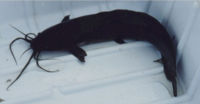Difference between revisions of "Clarias batrachus"
From The Aquarium Wiki
m |
|||
| Line 36: | Line 36: | ||
|max_water_hardness=20 | |max_water_hardness=20 | ||
}} | }} | ||
| − | |||
| − | |||
| − | |||
| − | |||
| − | + | == Origin == | |
| − | + | :Asia: Java, Indonesia. Clarias aff. batrachus from Indochina and Clarias aff. batrachus from Sundaland have been misidentified as ''Clarias batrachus'' from Java. Introduced elsewhere. Several countries report adverse ecological impact after introduction. | |
| − | + | ||
| − | + | ||
| − | + | == Sexing == | |
| − | + | :Mature males have spots along the anal fin. | |
| + | |||
| + | |||
| + | == Tank compatibility == | ||
| + | :Keep with large robust fish, anything smaller will be eaten. Suitable tank mates include large Cyprinids, such as the [[Bala Shark]] or [[Tinfoil Barb]], or Central American [[Cichlids]] (not African). | ||
| + | |||
| + | |||
| + | |||
| + | == Diet == | ||
| + | :Complete omnivore. Will devour anything including small fish, plant matter, pellet and flake foods, frozen/live [[bloodworm]] and [[brine shrimp]]. | ||
| + | |||
| + | |||
| + | == Feeding regime == | ||
| + | :Twice a day. | ||
| + | |||
| + | |||
| + | == Environment specifics == | ||
| + | :Large spacious tank with deep-rooted plants and places to hide, clay pipes are welcome decor as hideaways. | ||
| + | |||
| + | |||
| + | == Behaviour == | ||
| + | :This fish can survive for long periods out of water, hence it's name. They grow fast and will gorge themselves on any foods offered. | ||
| + | |||
| + | |||
| + | == Identification == | ||
| + | :A large fish with long dorsal and anal fins with a rounded caudal fin. Strong pectoral fins, which are used to help it "walk" when it's out of water. They come in several colours including the an olive/green brown, a piebald spotted and a naturally occurring albino. | ||
| + | |||
| + | |||
{{Categories | {{Categories | ||
|Category=Fish, Fish (Freshwater), Catfish, Airbreathing Catfish | |Category=Fish, Fish (Freshwater), Catfish, Airbreathing Catfish | ||
Latest revision as of 02:46, 13 December 2017
Clarias Catfish
Clarias batrachus
379 Litres (100 US G.)
45.7-61cm (18-24 ")
Freshwater
5.6 - 8.0
20 -26 °C (68-78.8°F)
8-20 °d
1:1 M:F
5-25 years
Family
Clariidae
Contents
Additional names
- Common Walking Catfish, Walking Catfish, Clarias Catfish
Additional scientific names
- Silurus batrachus, Clarias punctatus, Clarias assamensis
Origin[edit]
- Asia: Java, Indonesia. Clarias aff. batrachus from Indochina and Clarias aff. batrachus from Sundaland have been misidentified as Clarias batrachus from Java. Introduced elsewhere. Several countries report adverse ecological impact after introduction.
Sexing[edit]
- Mature males have spots along the anal fin.
Tank compatibility[edit]
- Keep with large robust fish, anything smaller will be eaten. Suitable tank mates include large Cyprinids, such as the Bala Shark or Tinfoil Barb, or Central American Cichlids (not African).
Diet[edit]
- Complete omnivore. Will devour anything including small fish, plant matter, pellet and flake foods, frozen/live bloodworm and brine shrimp.
Feeding regime[edit]
- Twice a day.
Environment specifics[edit]
- Large spacious tank with deep-rooted plants and places to hide, clay pipes are welcome decor as hideaways.
Behaviour[edit]
- This fish can survive for long periods out of water, hence it's name. They grow fast and will gorge themselves on any foods offered.
Identification[edit]
- A large fish with long dorsal and anal fins with a rounded caudal fin. Strong pectoral fins, which are used to help it "walk" when it's out of water. They come in several colours including the an olive/green brown, a piebald spotted and a naturally occurring albino.
Pictures[edit]
Videos[edit]
External links[edit]
- Fishbase (Mirrors:
 )
)
